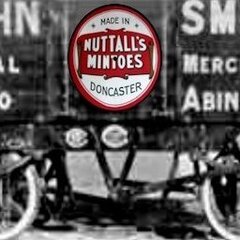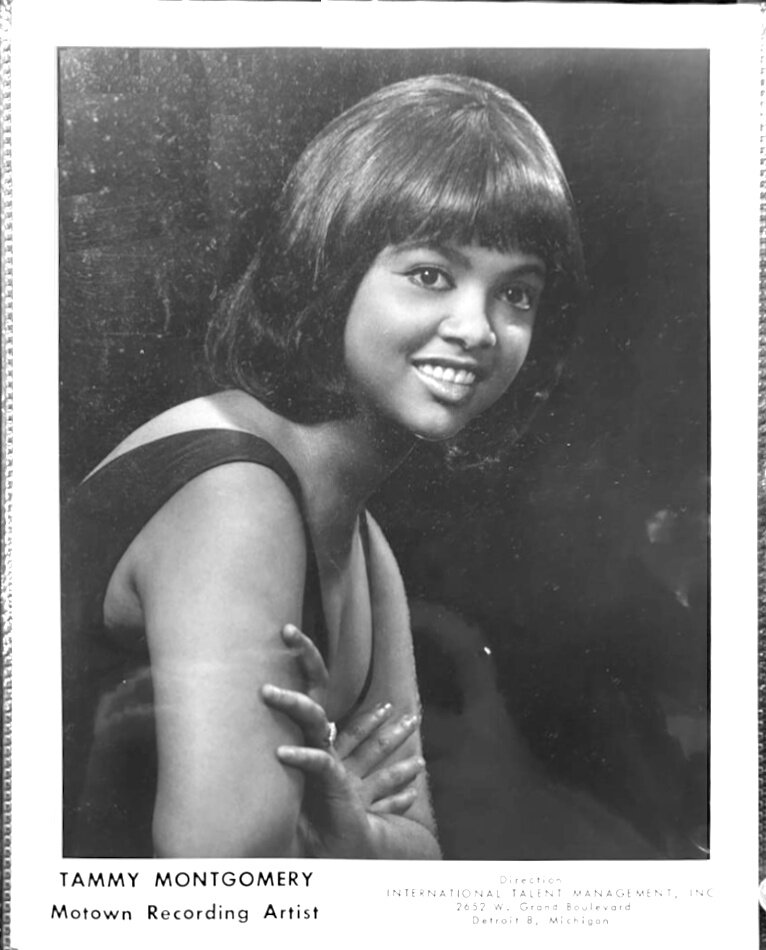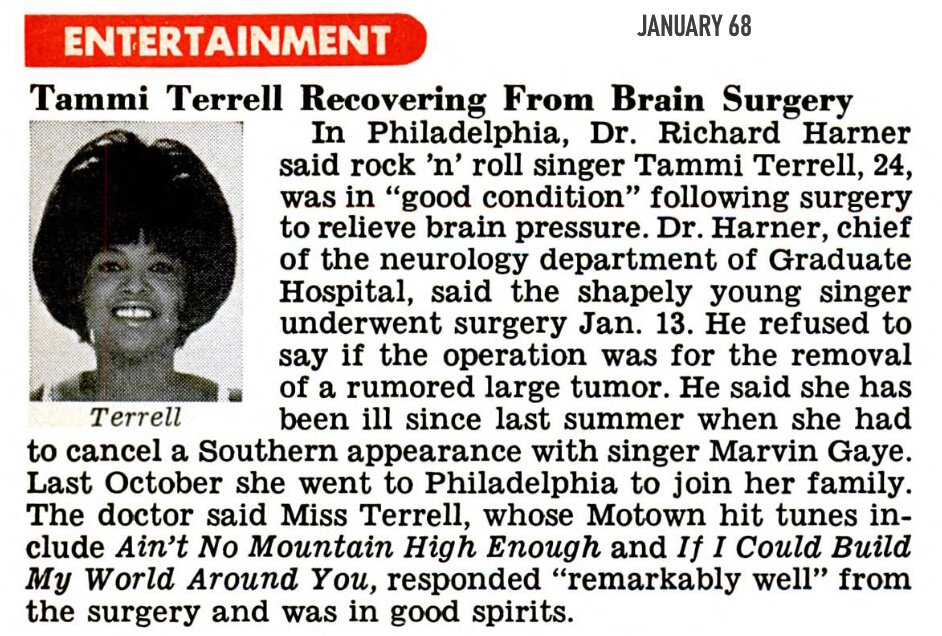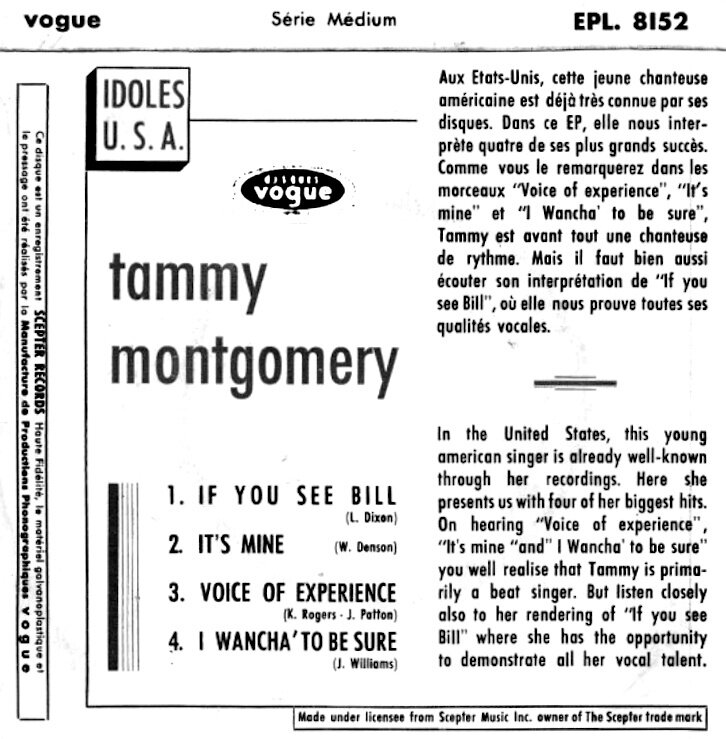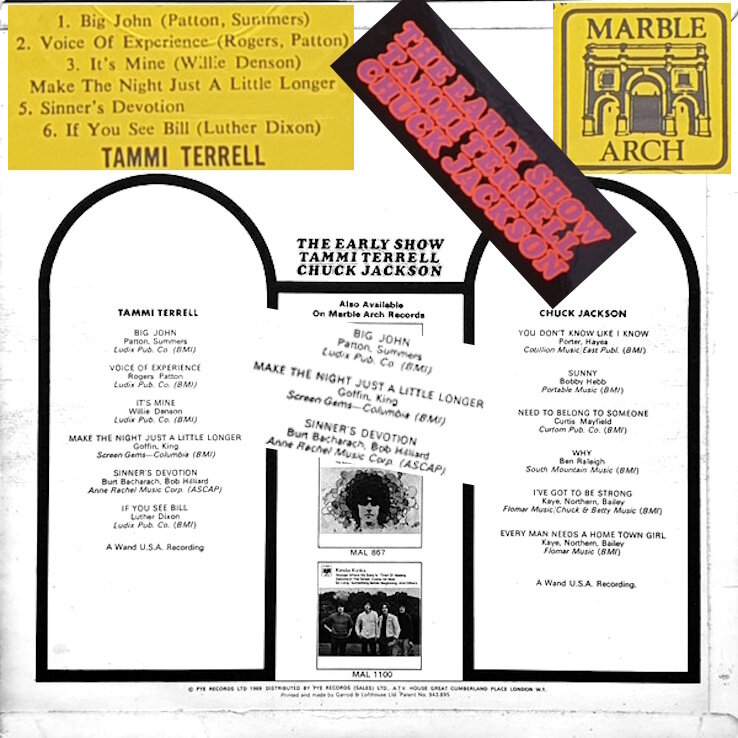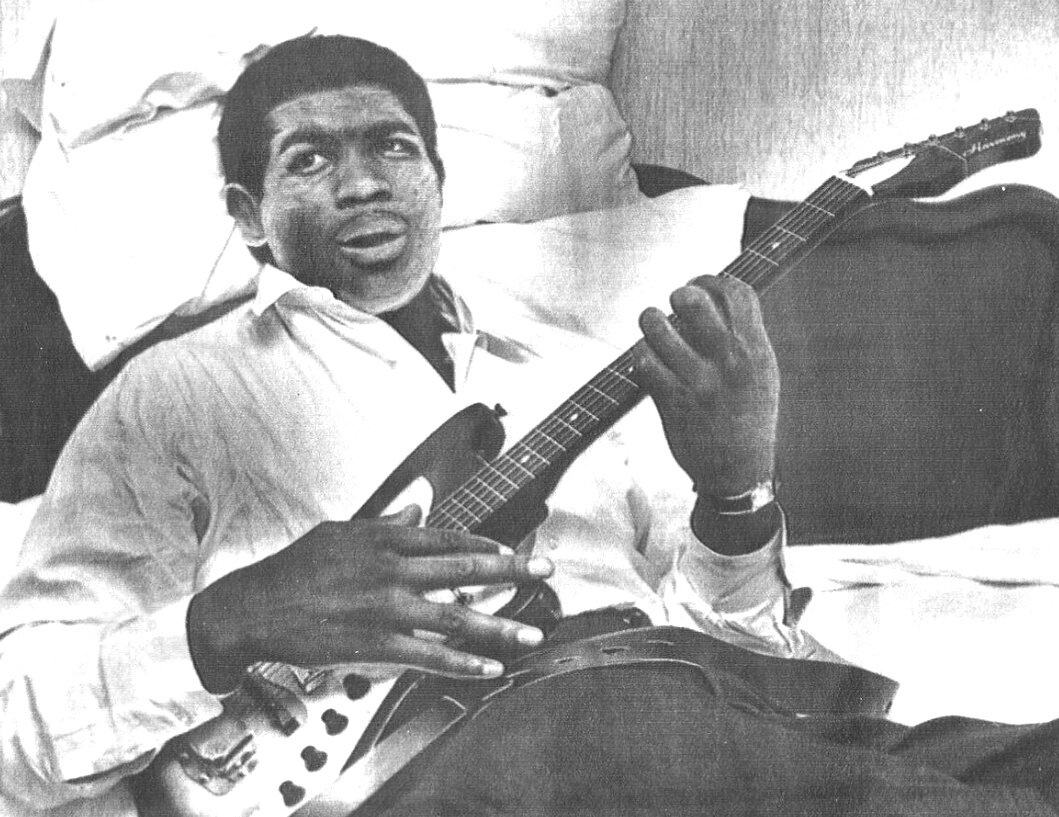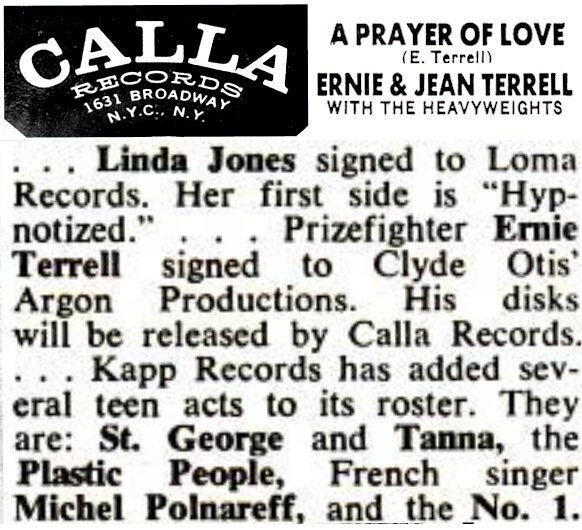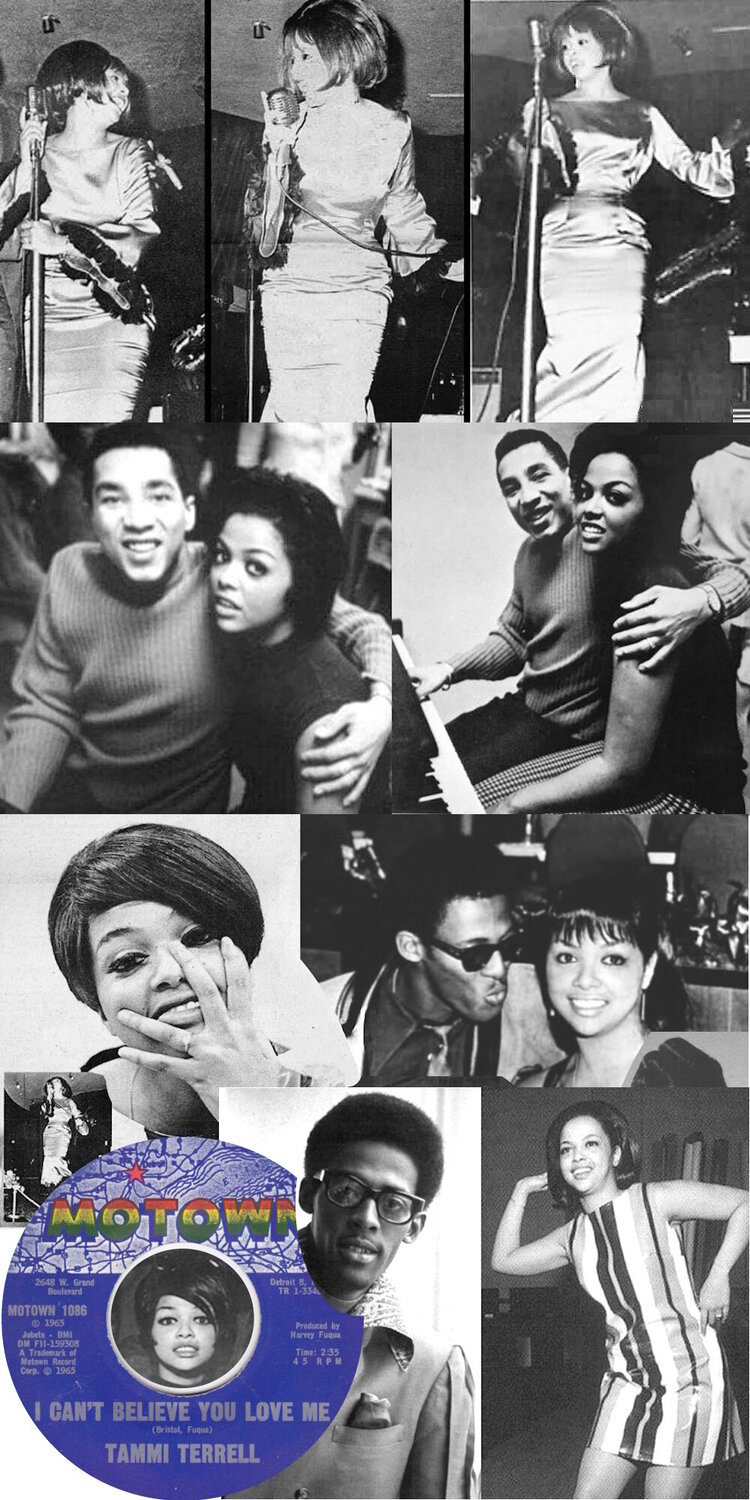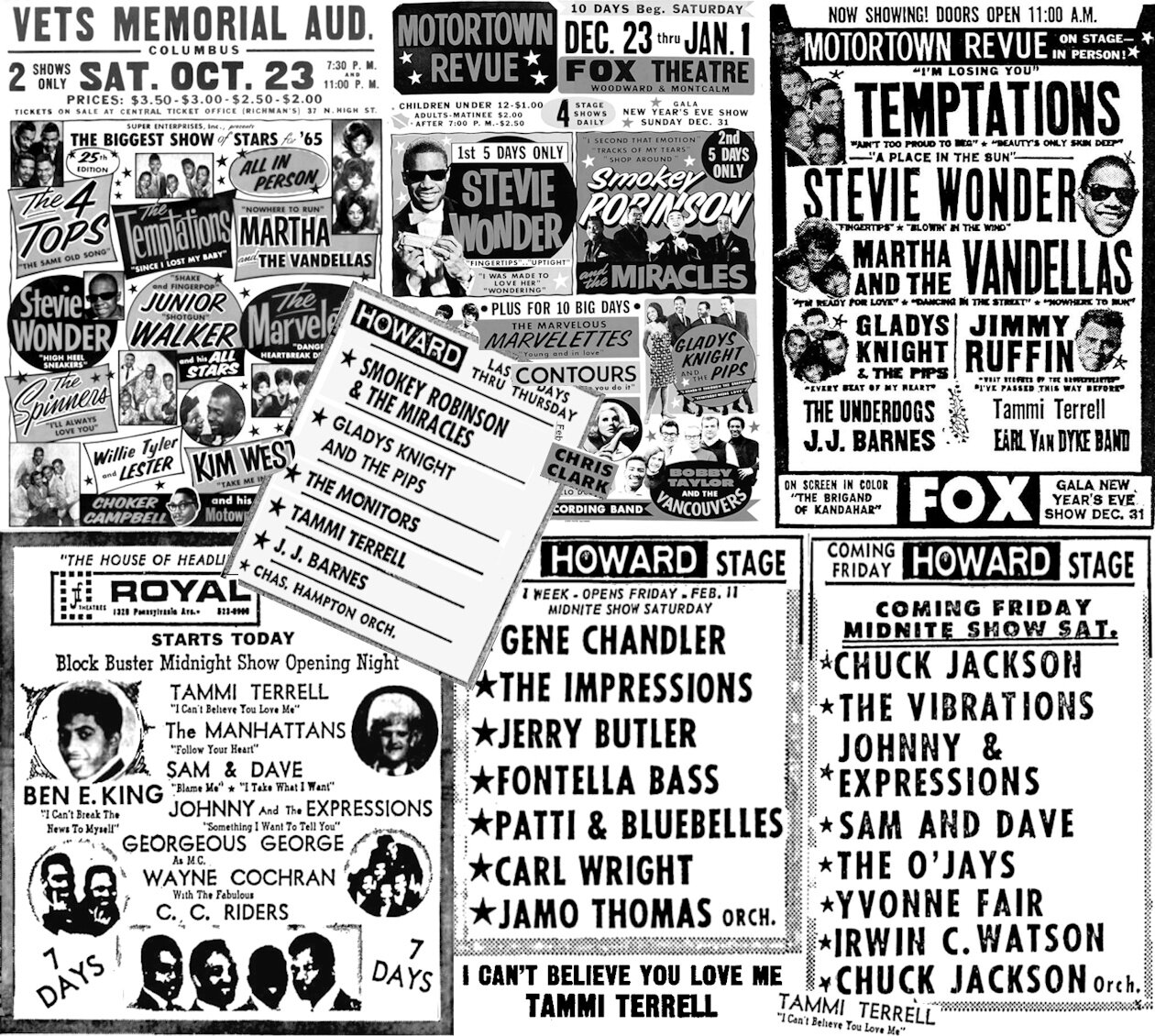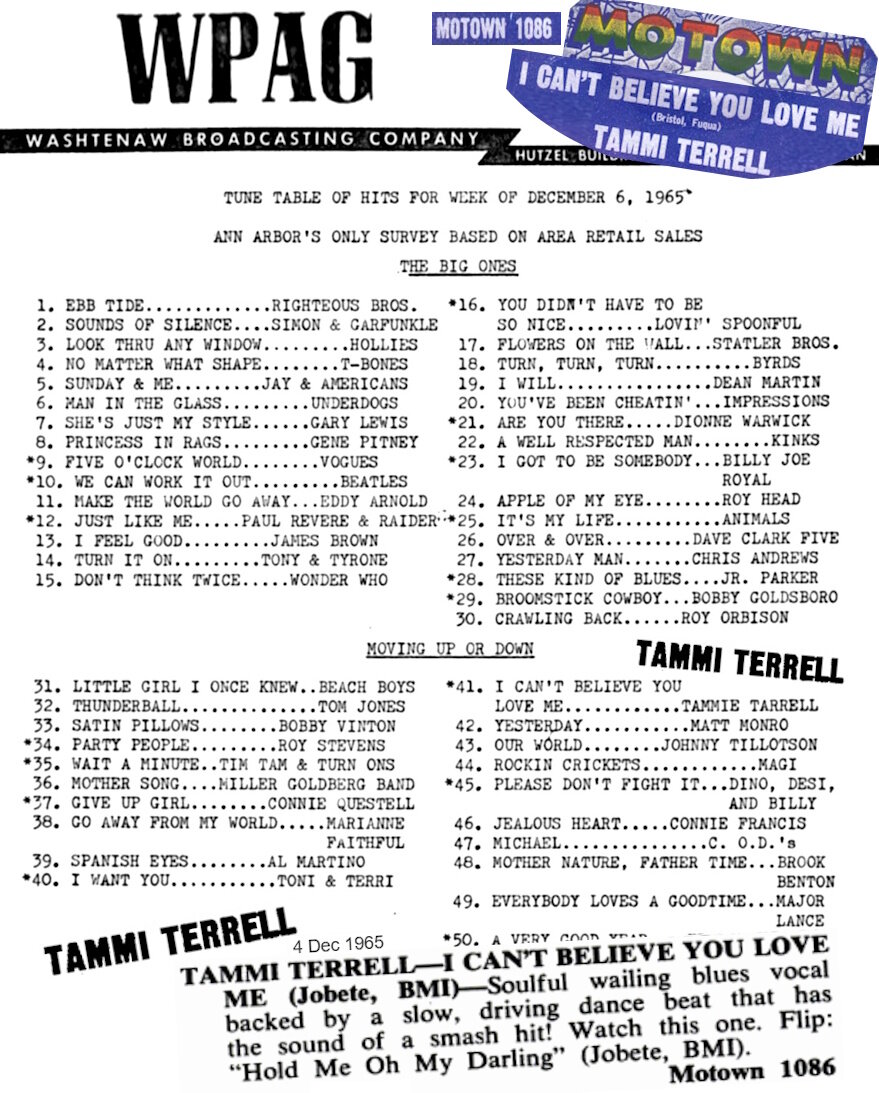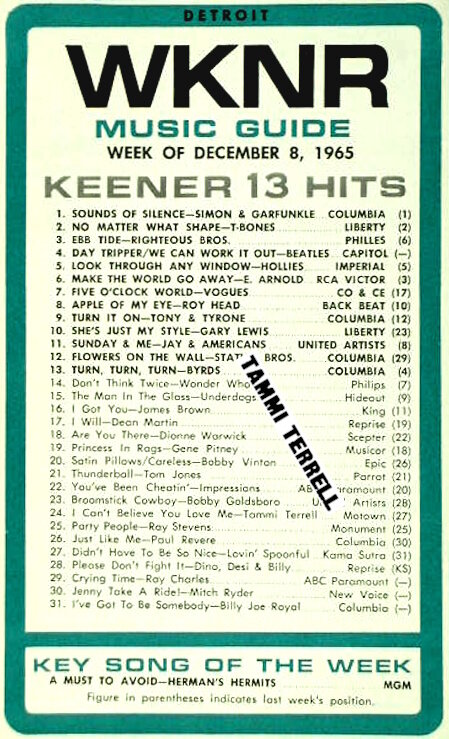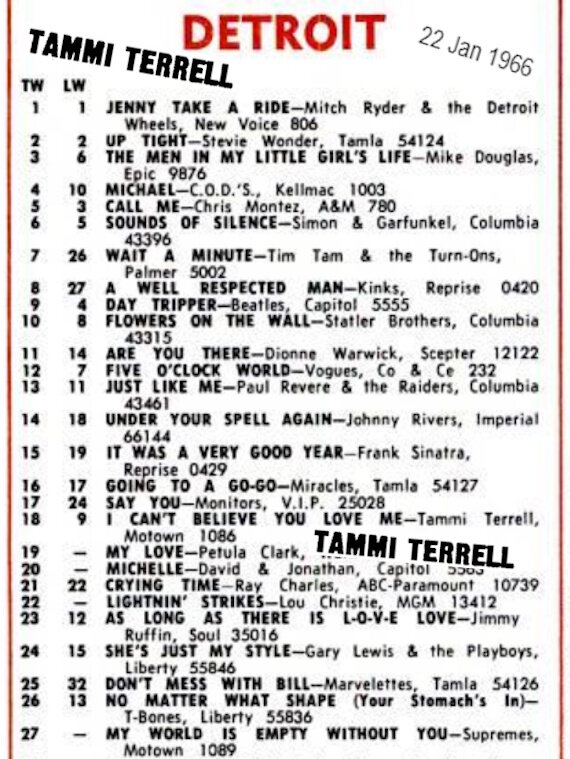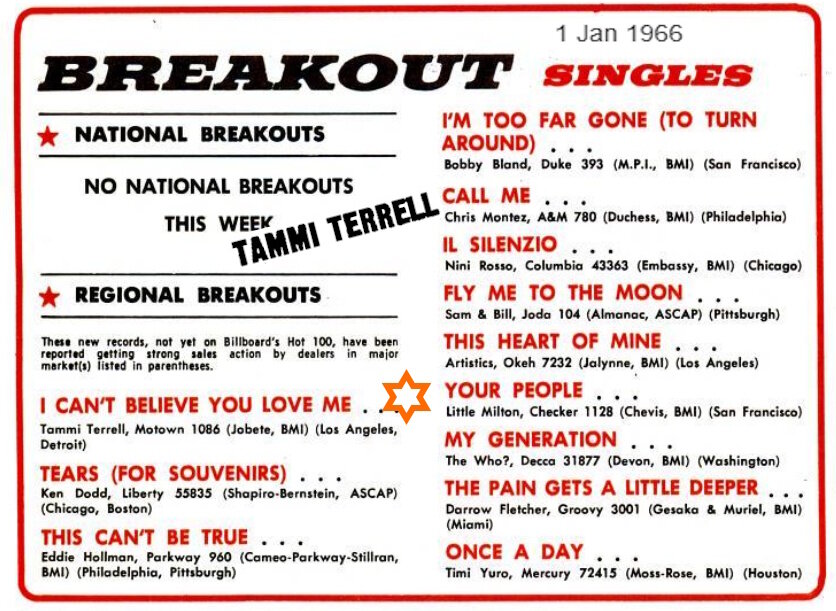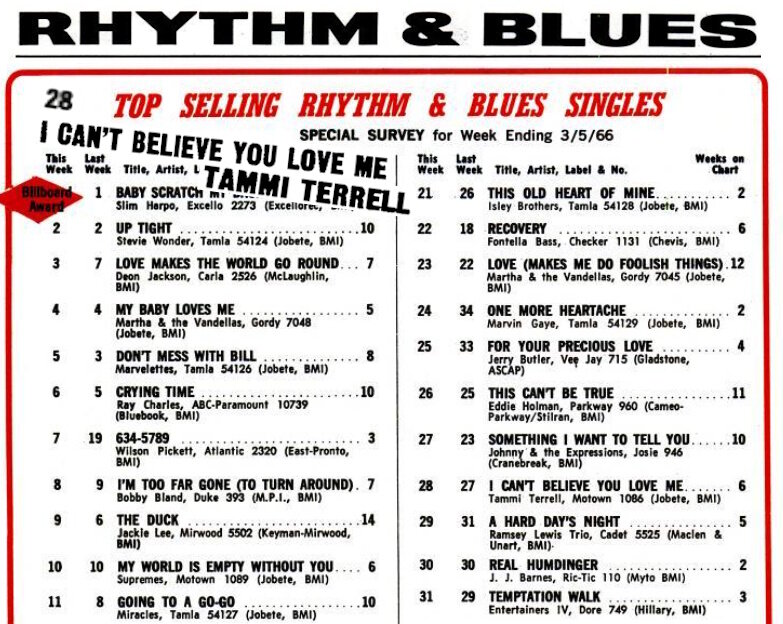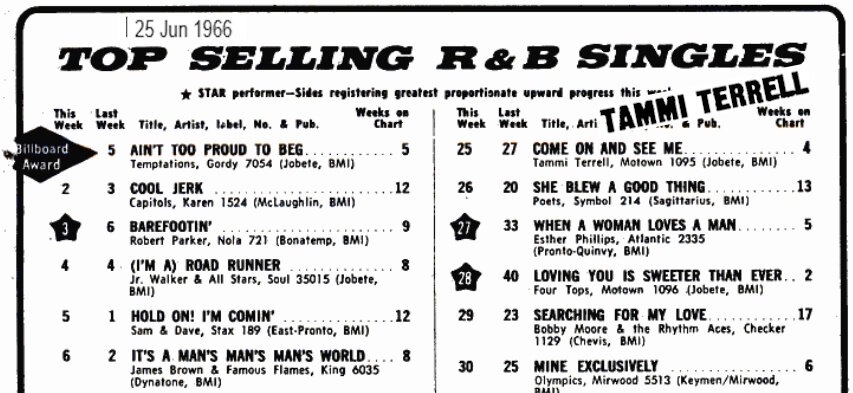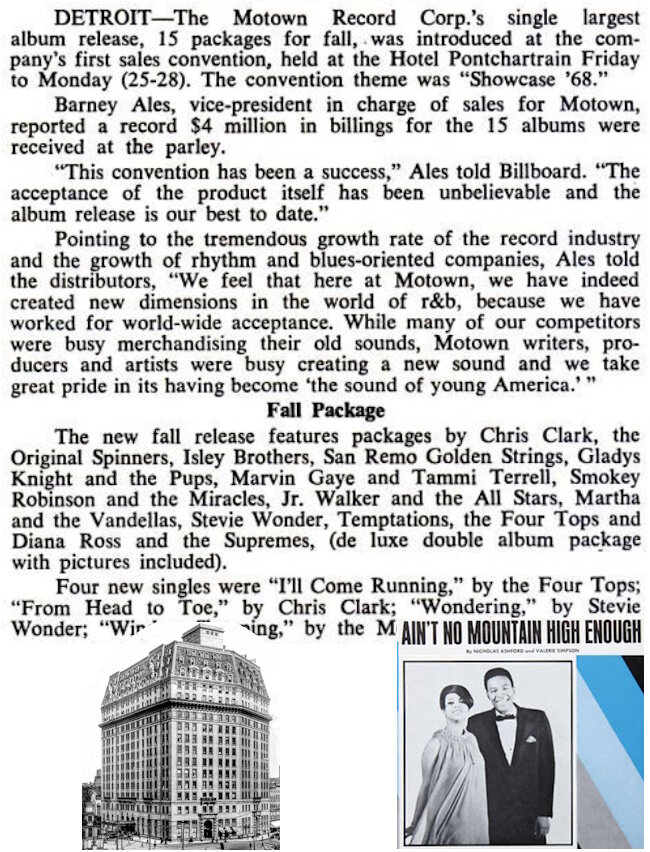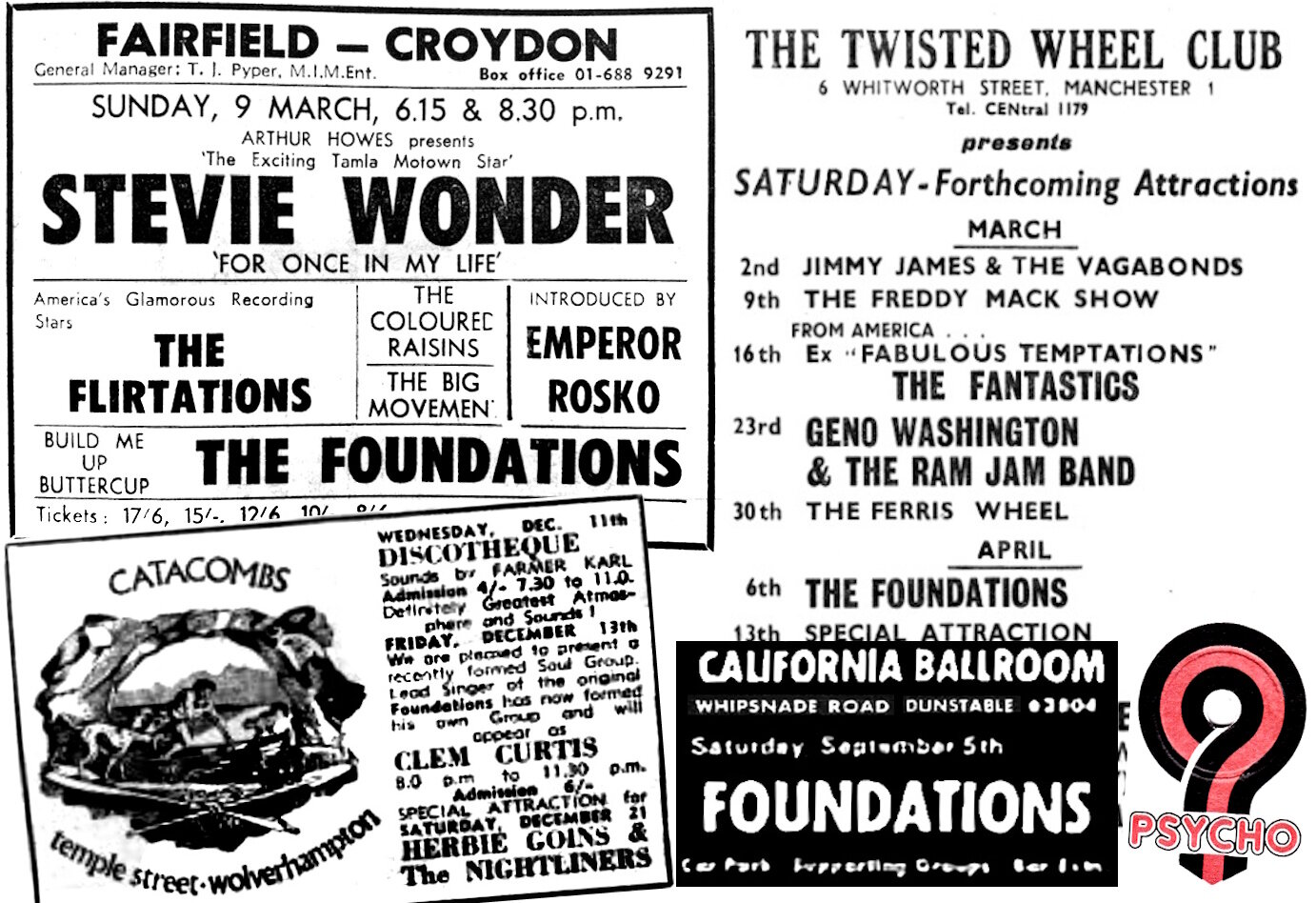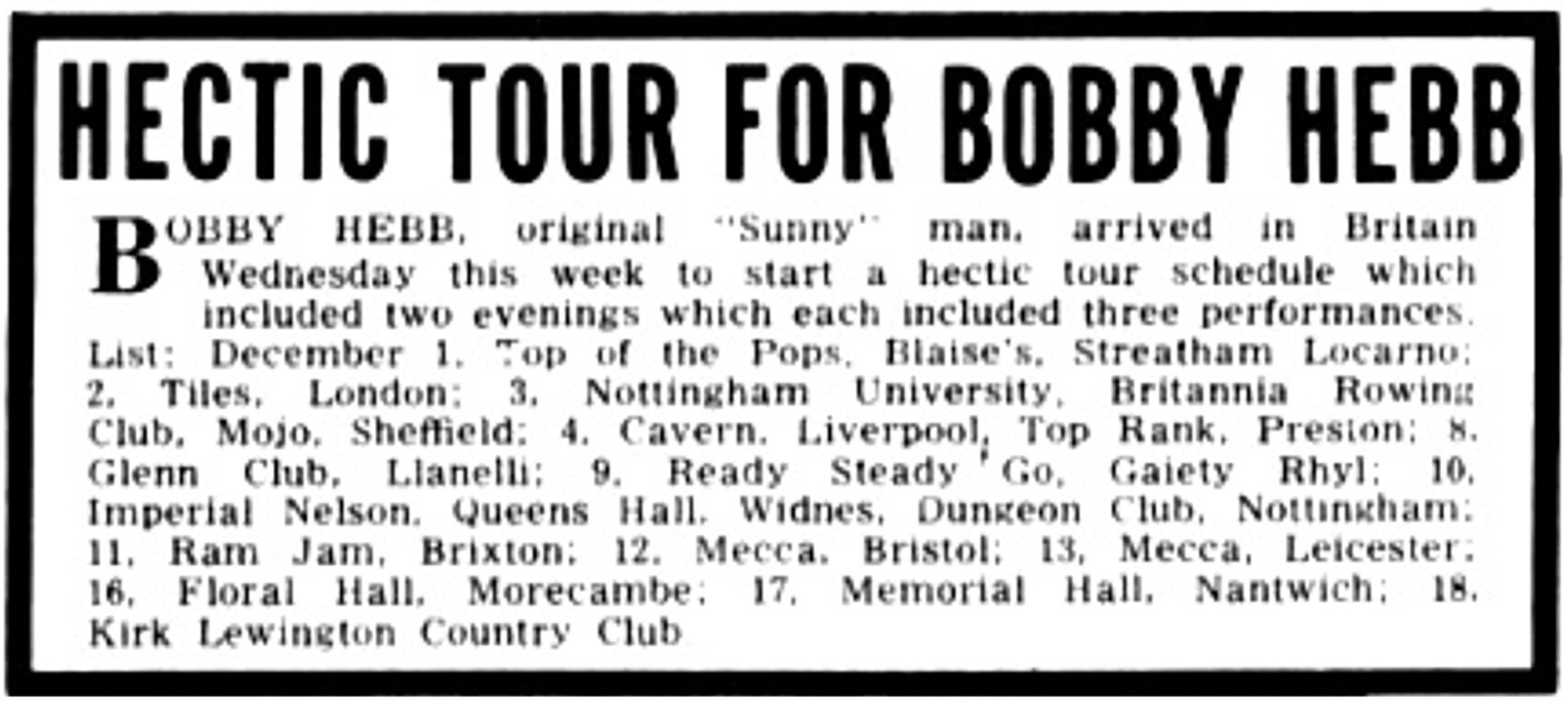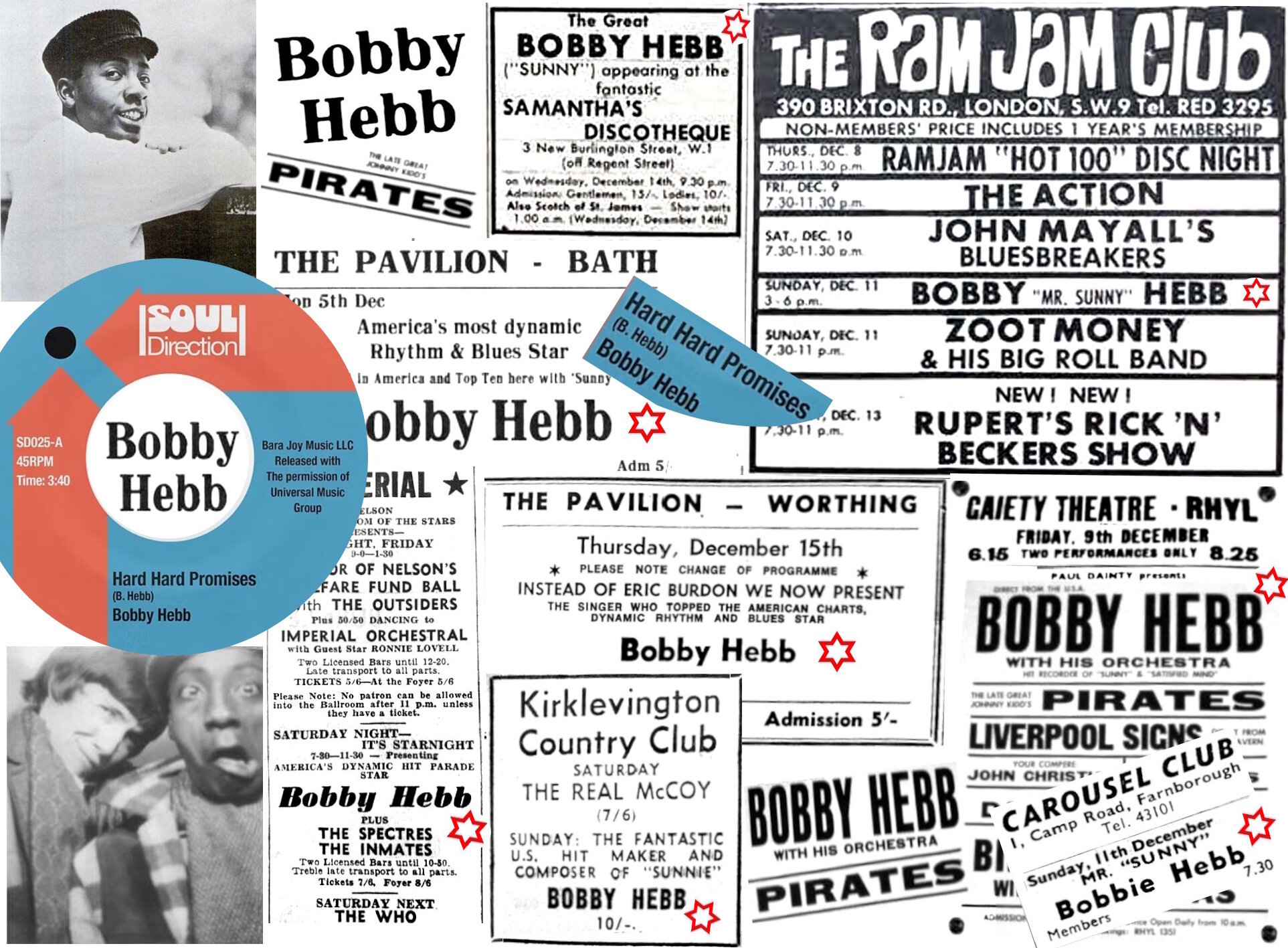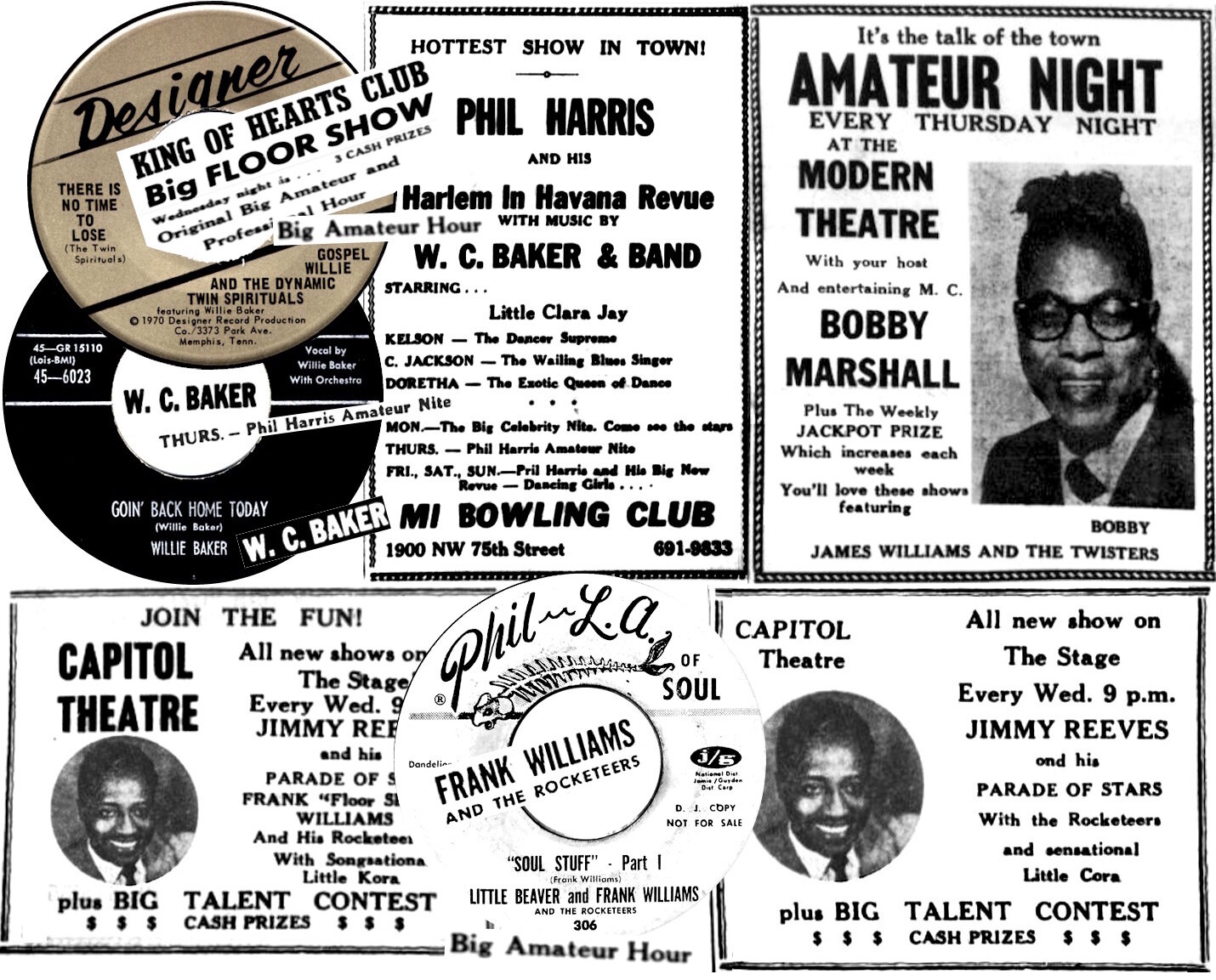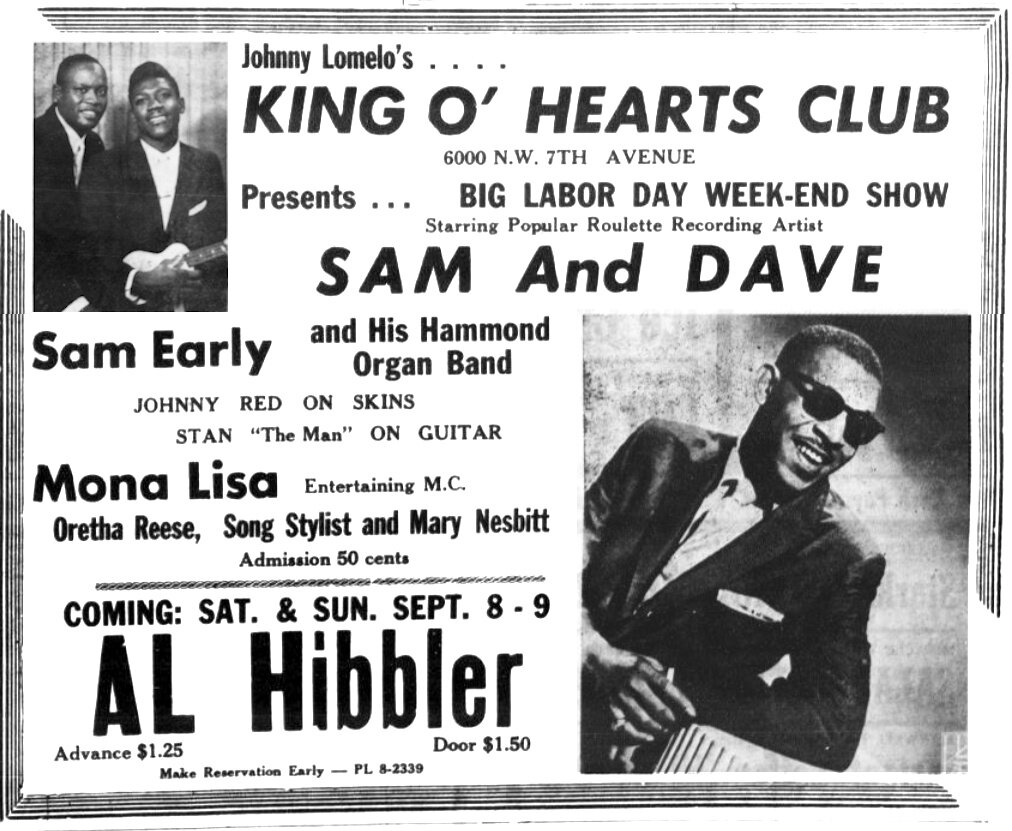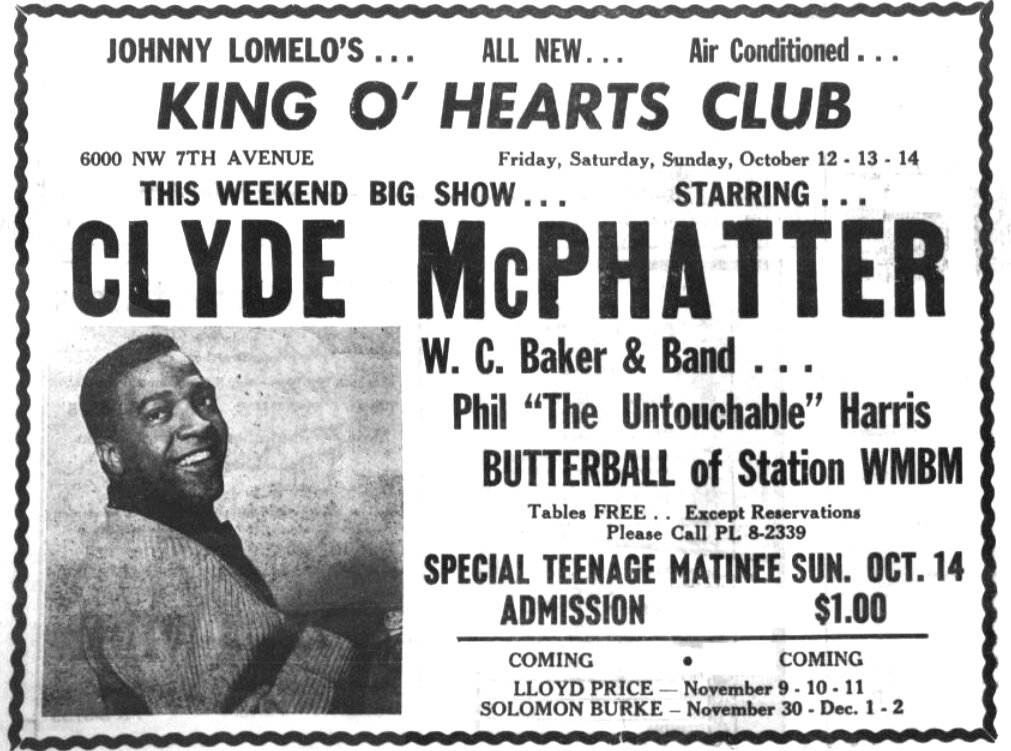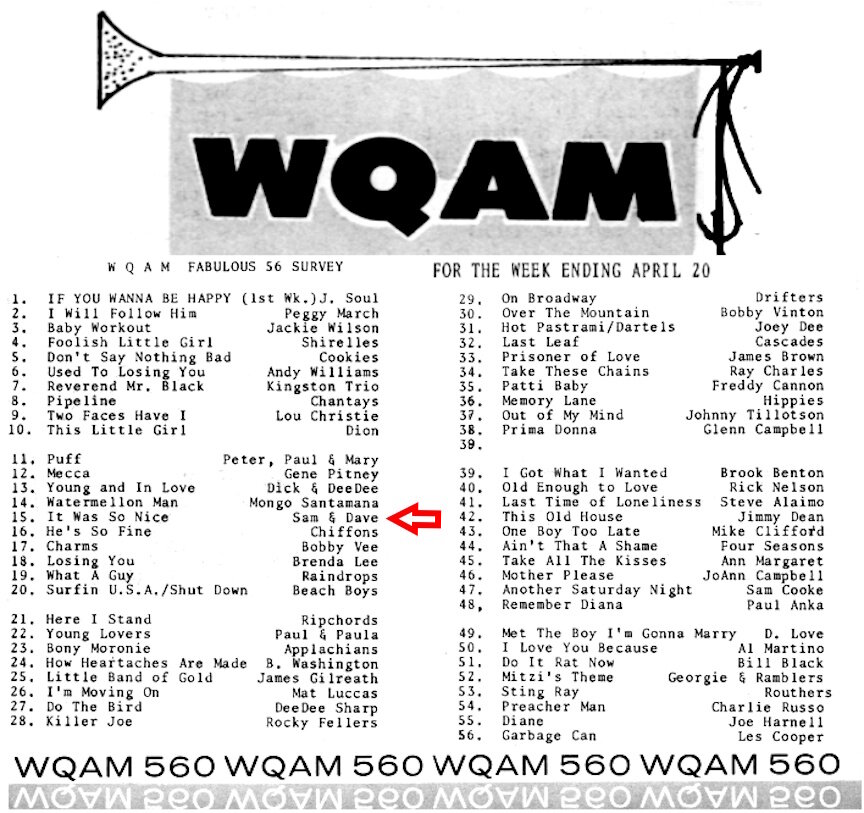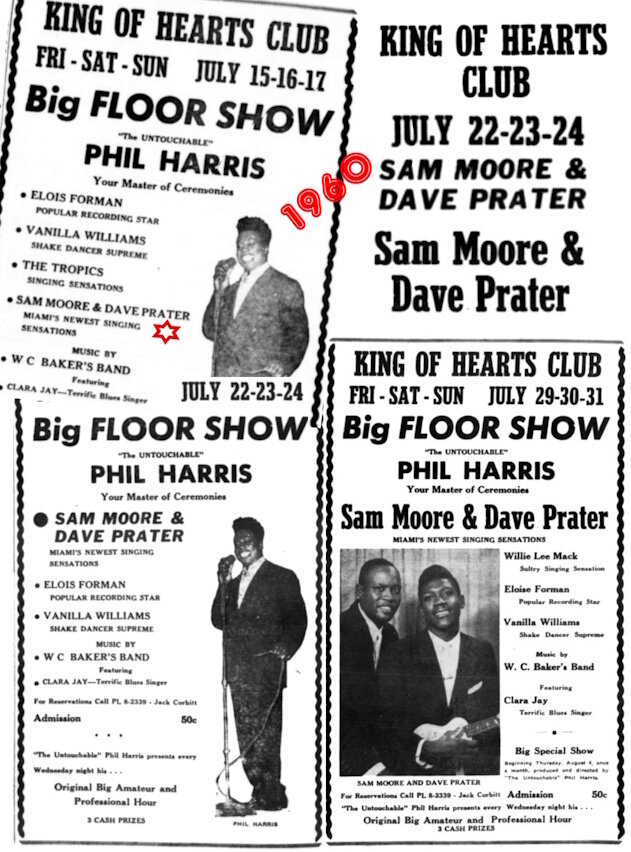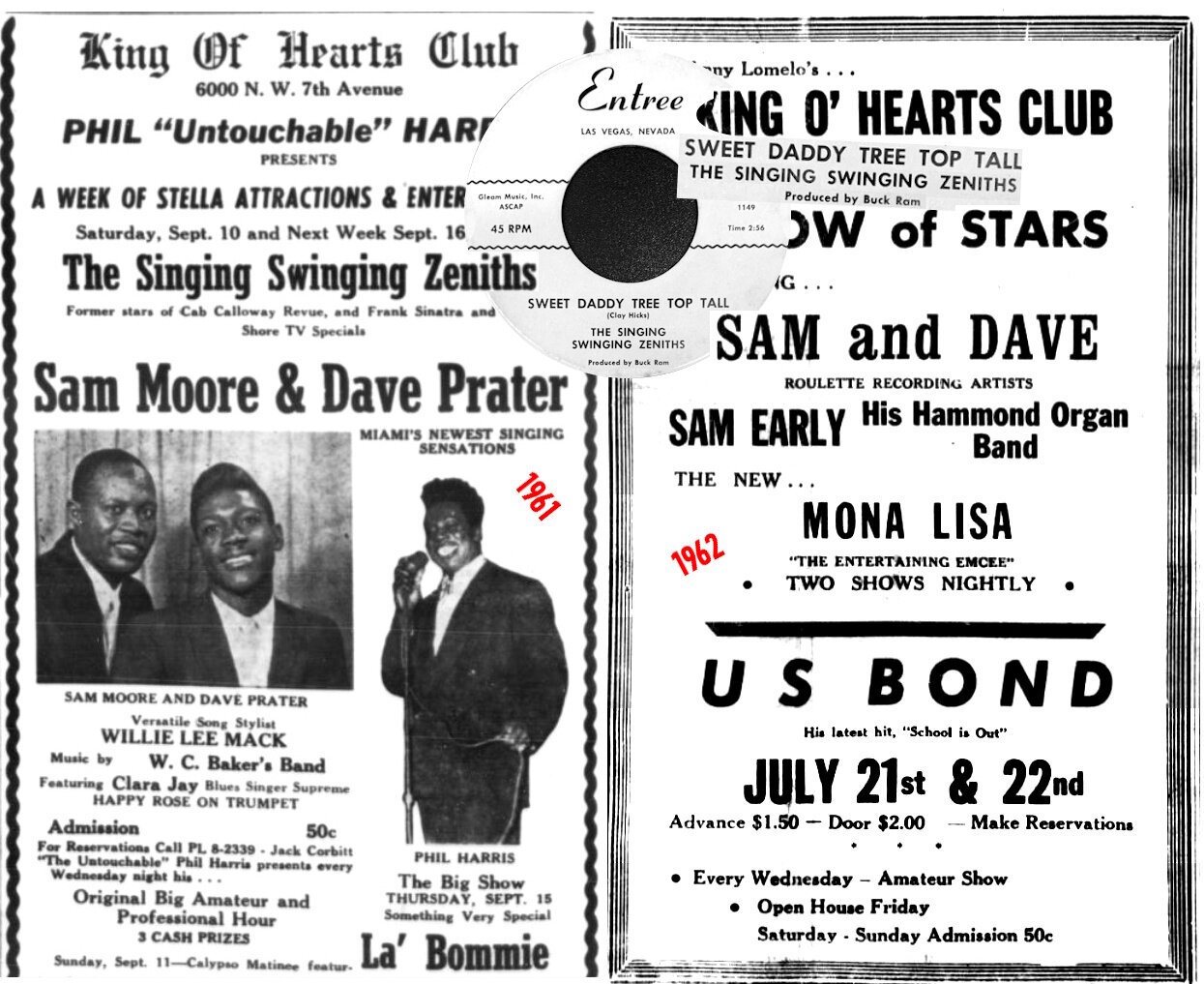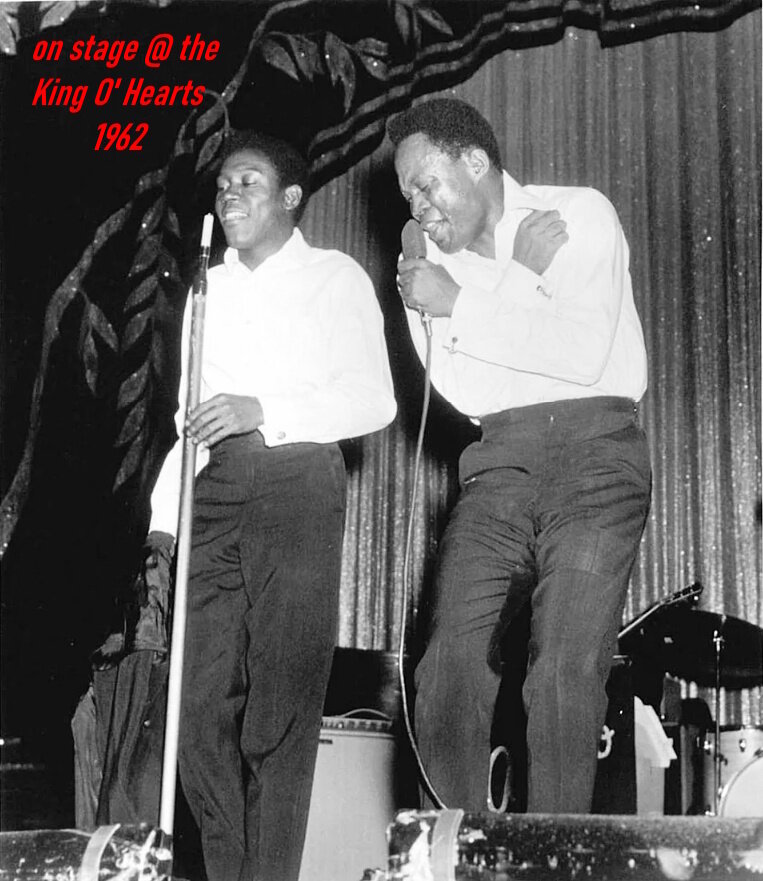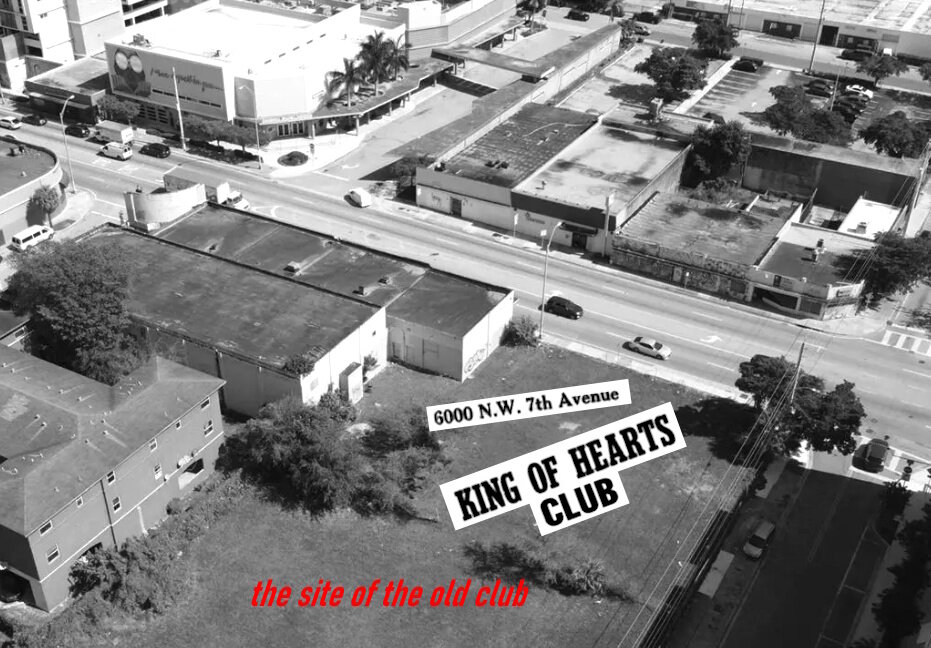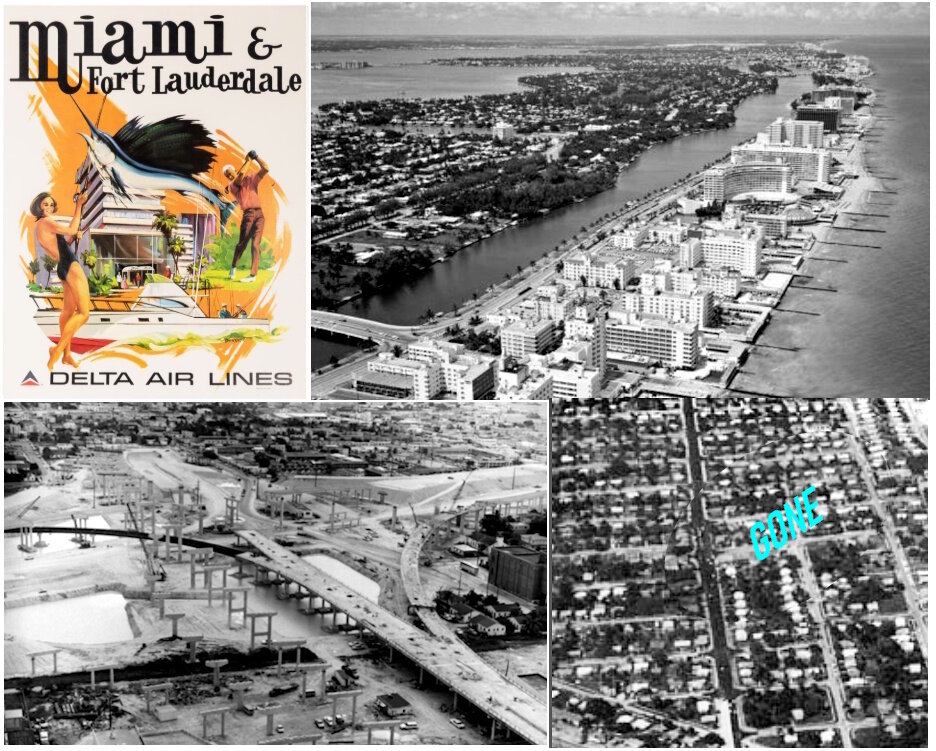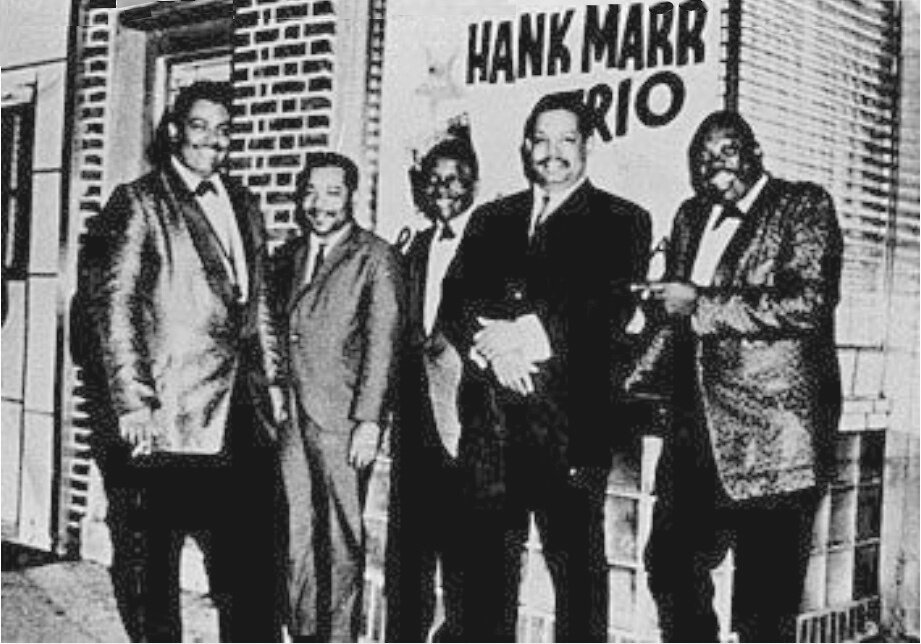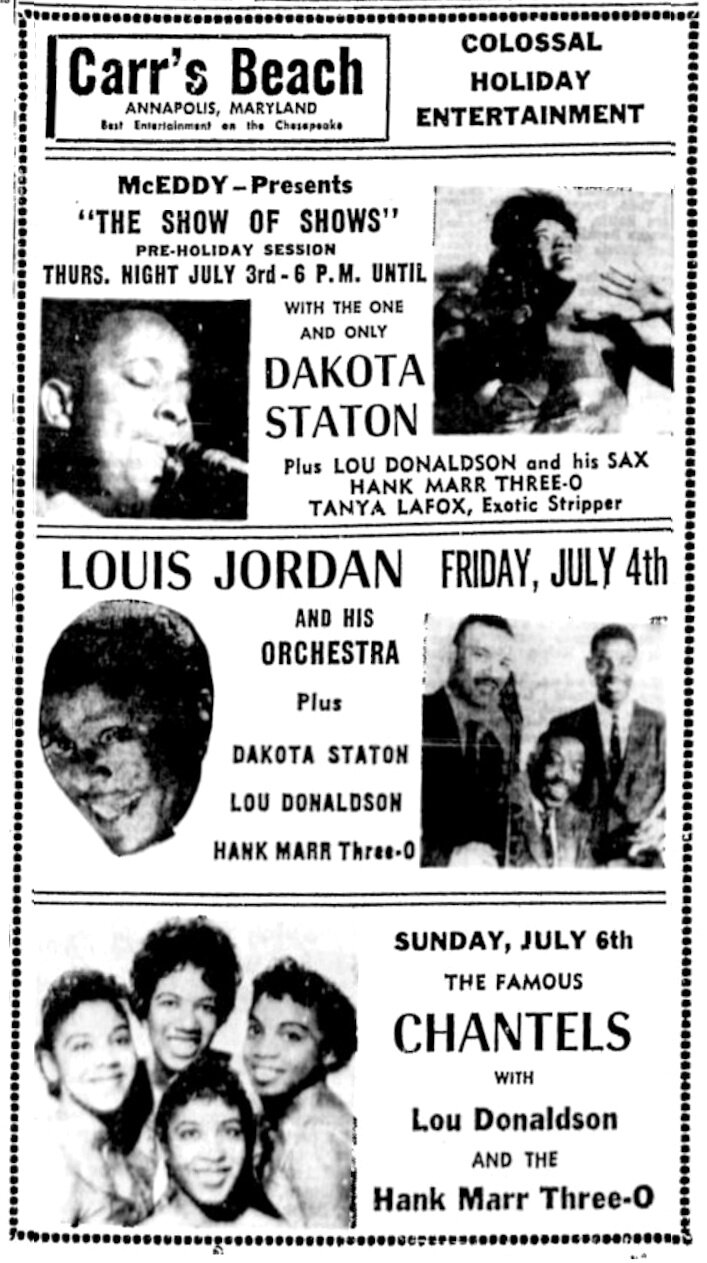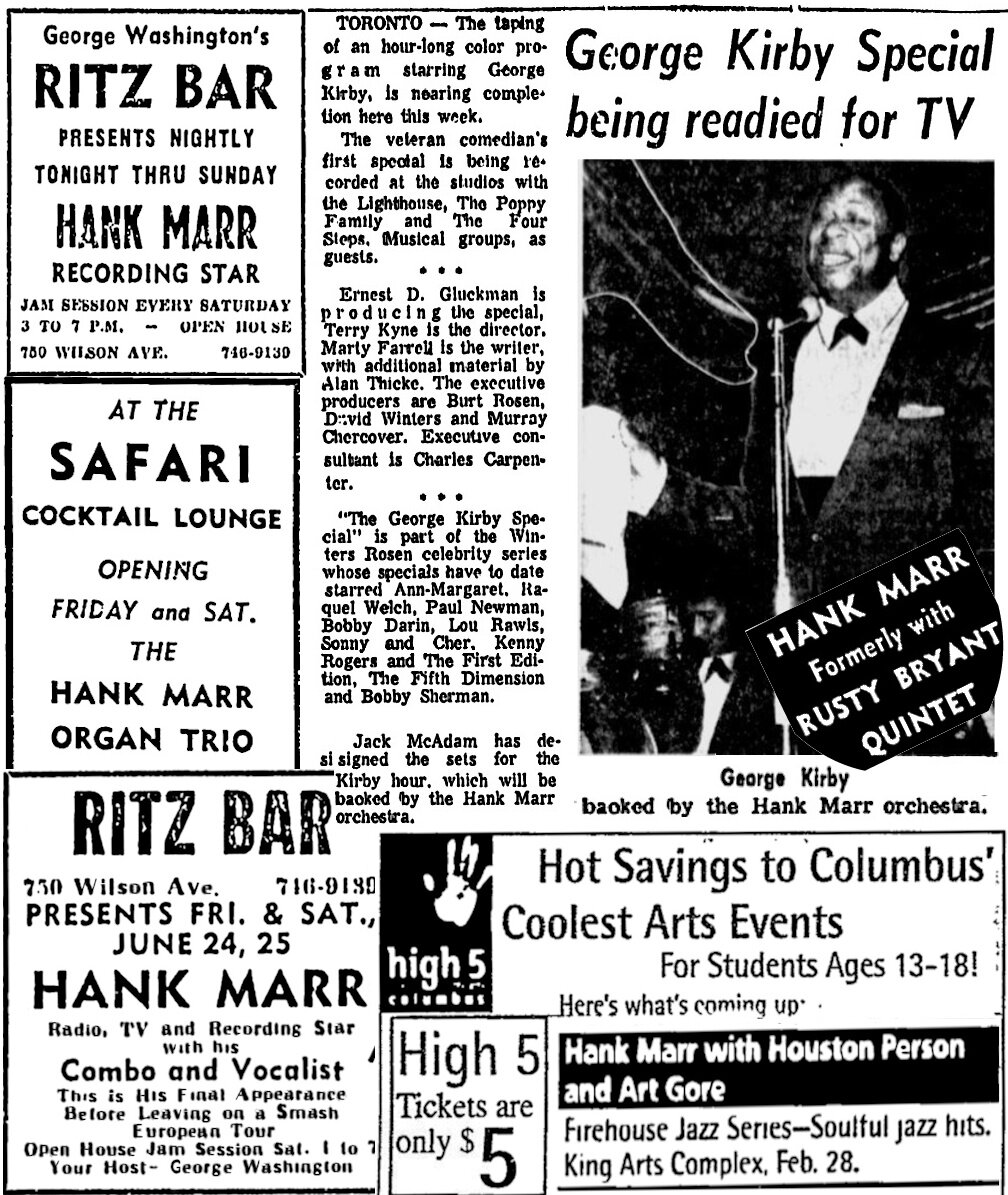Everything posted by Roburt
-
New Soul Releases
NOT REALLY NEW ... as it was made available around 9 months ago (though I hardly ever do digital) ... BUT caught the group on TV last night & they have been mentioned on here before ... this track really is the d*gs b*loxs ... Annie & the Caldwells "Wrong" ...
-
Andrea Hendry or Janice version of I need you ?
Little if anything is known about Janice. She's obviously a young lady & as Andrea Henry was Herman Griffin's (aka Herman Lewis) girlfriend in 1968, I'd guess Janice had taken over in that role by 1970. Reuse of the old backing track on this cut would point to it maybe just being a 'cheaply made throwaway' B side track ("I Thank You Kindly" being the plug side). It must have been licensed in by New York based Roulette, the deal being done with Griffin. Of course Roulette was infamously run (with an iron fist) by Morris Levy -- and was reported to be used as a front for money laundering by the Genovese crime family. The labels main act was pop group Tommy James & the Shondells & Tommy always stated that he was 'forced' to sign with the label. The Janice 45 was released in late June / early July 1970. At that time, the label was doing good business with 3 Degrees tracks that were also outside produced soul tracks (their "Maybe" selling well at the time). For the UK, Roulette teamed up with Major Minor. Not unsurprising, as Major Minor was run by the guys who owned Radio Caroline & Roulette Records sponsored a show on Radio Caroline presented by US DJ Jack Spector (this being taped in New York). Major Minor was releasing lots of US soul stuff in 1970 (Kim Weston, Howard Tate, Johnny Nash, Maxine Brown, Lenny Welch, Cissy Houston) plus stuff on their UK Roulette imprint (Geraldine Hunt), so the Janice 45 just might have been considered for UK release too. Two US Roulette 45's ( R7076 & R7078) from a similar time to the Janice single (R 7083) were put out in the UK but equally the US hit by the 3 Degrees ("Maybe" - R7079 ) wasn't. The Janise 45 got very little radio airplay in the US though it did do well on Denver based rock stn KTLK. Later in the 70's, there was a soul group named Janice who made some fine MS tracks but in 1970 they were still down in Nth Carolina and going by the name of the Reggie Sadler Revue back then. They never seemed to have any connections to Griffin / Lewis, though they did relocate in 1971 to cut for De-Lite in New York. So who Janice actually was I doubt we'll ever now know.
-
The 'Invention' of TAMMI TERRELL
I also asked my questions on SOULFUL DETROIT and got some of the answers to my questions ... Yes, they confirm it was Berry who changed her name to Terrell & who had her signed to a contract with Motown. . . . Over there (SDF) they also passed along this info .... On 16th Sept 65 she was in the Motown studio cutting "I Can't Believe You Love Me" and "Memory Chest" -- still noted down as being Tammy Montgomery. Tammi dubbed her vocals onto the cuts on 20th Sept 65. In November 1965, she was back for further studio sessions -- AND for these she was credited as Tammi Terrell. Her health had deteriorated to such an extent that by Jan 68 she needed a brain op.
-
News: New Album - Soul Jamaica - Various Artists - Soul Jazz Records
In the mid 60's, I liked / bought ska & Bluebeat 45's. When that genre of music stopped being played in mod / soul clubs, I stopped buying most reggae. HOWEVER, I was always a sucker for reggae versions of soul songs. Bought quite a few, including reggae versions of "Get Ready", "La La Means I Love You", etc. Some reggae artists didn't have the greatest degree of imagination. Irvin Brown cut lots of soul songs, including a few AL GREEN songs. He took the stage / recording name of AL BROWN & cut songs such as "Love And Happiness" and "Here I Am Baby". Think there was a similar compilation CD to this released in the past (got a copy here somewhere).
-
The 'Invention' of TAMMI TERRELL
Is it known if there are more unreleased pre-Motown tracks by Tammy / Tammi. Her US & UK (Marble Arch) LP contained 3 from Scepter / Wand that hadn't escaped on 45 ...
-
The 'Invention' of TAMMI TERRELL
Most places I've looked it states that Tammi was never married to the boxer, Ernie Terrell. Ernie Terrell was a singer, performer & recording artist too. He played live shows with his sister Jean, who would go on to be a SUPREME.
-
The 'Invention' of TAMMI TERRELL
Thomasina Montgomery (Tammi Terrell) was born in April 1945 in Philly. She suffered from health, mental and physical trauma problems through her life, following on from the agony of being raped when she was a teenager. Her singing career also began when she was just a teenager, recording for Scepter / Wand Records. Her first 45 release in November 1961 being "If You See Bill". She then spent two years as a member of James Brown's live show. The 17-year-old Terrell became involved in an abusive relationship with Brown (1962), who was 12 years older than her. Her 2nd single escaped in April 62 on Wand. In May 63 James & his team cut her on the song "I Cried" that was issued on JB's Try Me label. However, that same year Terrell left Brown's entourage after he assaulted her for not watching his entire stage performance one night. She then recorded for Checker Records (March 64) before signing with Motown in 1965. I can't find anything about her being signed by the company but it must have been in late summer 65 as they probably took her into the studio to record that October. She had been teamed with the production teaming of Harvey Fuqua (& Johnny Bristol). Promo copies of her 1st Motown 45 were pressed up in November & sent out to radio stns & music magazines -- her 45 starting to get airplay from the start of December. All her pre-Motown releases had been under the name Tammy Montgomery, so it must have been someone connected to Motown that re-named her. Motown were staging their big Christmas / New Year show @ the Fox Theatre in Detroit from late December through to the new year. Tammi wasn't originally down to be amongst the Motown acts on that show but it seems she was added due to the success her 45 was enjoying locally. Motown had been staging Motortown Revue shows since 1961 and 1965 was no different. But in 65 the tour was badged as being THE BIGGEST SHOW OF STARS OF 1965. As the revue went from venue to venue, some acts would be added whilst others dropped out (many called back to Detroit for recording sessions). On Saturday October 23rd the revue played the Vets Memorial Auditorium in Columbus, Ohio (the 4 Tops / Temptations / Martha & Vandellas being joint top of the bill). . . . JUST IN PASSING -- Muhammad Ali (Cassius Clay) defeated Floyd Patterson that night to become the youngest world heavyweight boxing champion at that time. The boxing match was broadcast live into US cinemas, so there must have been a real tug as to which venue to go to in Columbus that night. By the time the package did the Xmas show @ the Fox in Detroit (late December), the Temptations were top of the bill. It seems Tammi & David Ruffin met at these shows and quickly became romantically involved. They were soon an item & later in 1966, Terrell accepted Ruffin's marriage proposal. However she soon discovered that Ruffin was already married, had a wife, three children, and another girlfriend in Detroit. Their relationship however continued, but partly due to Ruffin's drug addiction, the pair would have violent arguments. In 1967, Terrell ended their relationship after Ruffin hit her in the head with his motorcycle helmet. In early 67 Motown had teamed her in the studio with Marvin Gaye. Their musical partnership resulted in the first single release as a duet -- "Ain't No Mountain High Enough"; Tamla - April 67. The partnership was highly successful and the pairing of Marvin & Tammi were a recording entity that Motown was giving a big push to by September 67. Lots more hit duets were enjoyed, the last of these being around the time of her death. Motown/ Tamla didn't really push any more of her solo releases, though she had been teamed with the likes of Smokey Robinson plus Holland / Dozier / Holland for tracks released on her solo album - 'Irresistible Tammi Terrell- M #652 (January 1967 / November 68 ?). However, Tammi's health continued to be problematic & she would pass away in March 1970. MY QUESTIONS .... .... anyone know who instigated her signing to Motown ? ... who came up with the stage name TAMMI TERRELL ? .... the release # of her solo album -- 'Irresistible Tammi Terrell- M #652 would suggest it was originally down for a January 1967 release. But it didn't seem to emerge till November 68. Was this coz by then she was becoming too ill to record much and so they decided to put out lots of the earlier solo tracks that had been laid down ? I don't yet have a copy of the book her sister wrote about Tammi. The above questions may well be answered in that.
-
Manship half price sale
Ordered a few of his web site on Sunday (nothing rare). Not got them yet, but not getting worked up about it -- I've waited 50 years to add some of 'em back into my collection, so a few days added wait isn't of any concern.
-
Spot Records of Mayfair
Janis, I'll be in touch.
-
Sam Moore -- his start in life (& the music biz)
A good piece on Sam & Dave later in their career ... The Legacy Of "Soul Man" By Sam & Dave: A Timeless Anthem Of Resilience And Joy - DH MusicThe Legacy Of "Soul Man" By Sam & Dave: A Timeless Anthem...When you hear the opening guitar riff of "Soul Man," you’re instantly transported to a world of rhythm, grit, and unbridled soul. The song, recorded by
-
News: Soul Up North #125 - Autumn 2025 Out Now
My piece in the current edition is about the Foundations. Even though the group recruited Joe E Young as their lead singer after Clem Curtis went out on his own & have a few 'collectable 45's, they tend to be looked down on in NS circles. However they did versions of lots of classic soul dance tracks & played lots of the iconic soul venues back in the day ...
-
Jimmy Ellis vs. Jimmie Preacher Ellis
Probably way off beam here ... BUT .... Bobby Rush cut for SALEM and his given name (when born) was Emmett Ellis Jr. So he was a member of the Ellis family. Just maybe he was still signed to another set of producers (Wally Roker / Barry Despenza ?) but unwilling to cut for them again -- so he invented a Christian name & used his original surname to get a 45 out on Salem.
-
News: New Bobby Hebb Release From Soul Direction 45
Bobby Hebb undertook a successful UK tour back in 1966 ... He got on well with his backing band but I believe the mode of transport (all packed into a transit van some of the time) and the accommodation (old lady run B&B's) left much to be desired. Bobby also had to adapt to British food & the weather here (wet !). He got very homesick by all accounts & his spirits only lifted when the time approached for him to fly home to the US. The UK booking agent (Roy Tempest ?) had booked then 2 & 3 shows a night to increase the level of fees coming in (& his %) but took little account of the distance between the different venues. The backing band had been Johnny Kidd's Pirates & Johnny had just been killed in a road crash heading between gigs. So for the Pirates first gigs in their own right, backing up Bobby Hebb on his UK tour, racing between gigs was a big no-no. Lots of the additional shows (the 3rd one of the night) had to be missed and I believe this was the reason he never got to play Sheffield's Mojo Club. Also, one night they were booked to play Nelson (Lancs) Widnes & Nottingham -- so the Widnes show was missed out. Without motorways though, the dash from the Imperial Ballroom, Nelson to the Dungeon in Nottingham must have been a bit of an ordeal.
-
Sam Moore -- his start in life (& the music biz)
Back in 1960, Dave Prater was trying to make his way in Miami by turning up & performing a club amateur night contests. That's how he got to team up with Sam Moore. Those amateur nights were big business back then & actually turned up some real talent. At the daddy of them all, the Harlem Apollo's amateur night shows, lots of major artists got there start in the music biz. It was the same down in Miami in the early 60's AND lots of great bands were there providing the musical back-up. The likes of Frank Williams Rocketeers and "Willie" W C Baker & his Band wouldn't have gotten involved if they didn't think there was something in it for them too. I'm sure the likes of Frank Williams would have been on the look out for likely vocalists to front his two bands on their live shows ( ... the Rocketeers became such a popular outfit for live shows, that he had to start a 2nd version of his band in order to meet all their booked engagements). It was handy for Frank to have a potential replacement on call when the likes of Little Beaver went out on their own after having built up a following as Frank's bands lead vocalist. Where Sam & Dave got their start -- the King O' Hearts -- Wednesday was the night of the amateur show & cash prizes were on offer for the contest winners. Audiences would turn up to witness these performances (much like they do for America's Got Talent I guess).
-
Robert Plant's "I've Got A Secret"
My question answered. Many thanks. It makes sense really that Ed Kassner would have links to the guys @ One-derful. One of the early soul releases on UK President (he owned / ran President too -- both the US and UK arms of the company) was of course the Mar-V-Lus 45 by Alvin Cash & the Crawlers "Philly Freeze" (Oct 66). In fact the Leaner Bros were so tight with Kassner, that they made EMI withdraw their Stateside 45 version in favour of Kassner's President 45 release. As EMI were the biggest record company in the world at that time, that was a bold move to make.
-
Sam Moore -- his start in life (& the music biz)
Later in 1962, Sam & Dave were still resident @ the King O' Hearts in September. The first ad for the club I can find where they don't seem to still be on there was in mid October 62 ... their 3rd Roulette 45 was released just weeks later. Their 2nd Roulette 45 was on the charts in Chicago, Atlanta & Birmingham in October, so they might have been off promoting that ...
-
Sam Moore -- his start in life (& the music biz)
Sam & Dave's Roulette 45 on a local pop radio stns chart in 63 ... sharing space & the airwaves with the likes of Peter, Paul & Mary, Andy Williams and Ann Margaret.
-
Sam Moore -- his start in life (& the music biz)
A selection of records on the charts when Sam & Dave would have been selecting the songs they'd include in their act after first getting together as a duo ... ... not too many of them that would seem to suit their gospel tinged style ... BTW, it was 50 cents to get into the club, $1.50 if they also had a visiting big act on > EXTORTION !!
-
Sam Moore -- his start in life (& the music biz)
A DAY LATE BUT STILL WORTH POSTING ... Sam Moore was born in Miami’s Overtown neighbourhood on Oct. 12, 1935, so (if he were still alive) yesterday would have been his 90th birthday. Moore was raised in a house on Third Avenue in Overtown mostly by his mom. He went to Phillis Wheatley and Paul Laurence Dunbar elementary schools in Miami. He briefly lived with an aunt in Fort Lauderdale where he attended Dillard High School. Moore graduated from Booker T. Washington Senior High in Overtown in 1955. He was soon attempting to establish a singing career but was struggling to get it to take off. Unbeknownst to Sam, another young singer - Dave Prater - had relocated to Miami from Georgia in 1957. Prater had started out singing gospel in the choir in his local church. He then joined his older brother, JT Prater, in the gospel group The Sensational Hummingbirds. But fame beckoned & he'd relocated to Miami. By 1960, both guys were performing solo shows in local black nightclubs around the Miami area without a great deal of success. Then, one night in June 1960 Sam attended a show at the King O' Hearts club (6000 NW Seventh Ave. in Miami’s Liberty City). The club staged amateur shows along side the established local acts who were also playing the venue. A nervous aspiring gospel trained R&B singer, Dave Prater, was struggling up on stage. Moore, who had similar musical roots and ambitions, recognized Dave's talent and decided to help out. He went on stage too & coached the younger guy, helping him to remember the words to the song he had to perform. Dave managed to get through his performance that night and a new friendship had been established. Soon (a matter of days later) Sam & Dave decided to perform together as a duo and the owner of the King of Hearts club (John Lomelo Jr) instantly knew he could be onto a winner. He signed the guys up to a contract that tied them to perform at his club as a duo for an extended period. The pair sorted out an act (singing recent soul chart sounds and classic hit songs) and began to perform together. The word soon got out. In early July 1960 they were yet another act on a busy bill trying to appeal to the club's audiences. Just a week later they'd been moved to top of the bill, another 7 days passed & their photo had been inserted into the club's ad ... a meteoric rise towards stardom. The club now had no need to place weekly ads in local newspapers, the plce filled up anyway as the duo's fame spread locally. When the club decided to also book a named act, the owner would place an ad, however Sam & Dave would still be on the bill. Even after they'd done some recordings locally and these had been sold on to New York based Roulette Records (March 62), the pair were still starring at the King Of Hearts. Their Roulette 45's didn't set the world on fire, though "No More Pain" (1962) hit the radio charts in Trenton, Atlanta & Birmingham. Their May 63 outing, "It Was So Nice While It Lasted" did almost as well, charting strongly in Miami (making WQAM's Top 20). But it wasn't enough for Roulette and 1964 found them back on the local Alston label. But top soul acts visited Miami to play shows, especially in the winter months, when the weather down south attracted snow birds. One such snow bird was Atlantic Records Jerry Wexler. In summer 1964, Henry Stone, who owned Alston Records, introduced the duo to Wexler. Quickly signed to a deal with Atlantic, they would be sent up to Memphis by the Atlantic supremo to cut in the studio of a southern label that Atlantic distributed, Stax Records. The rest of the story became soul history soon after the release of their first Stax 45 in March 65. The duo's 2nd Stax outing was "I Take What I Want" and this hit the charts in Washington DC, Detroit & LA (+ in Florida of course). The next release, "You Don't Know Like I Know "(Nov 65) hit the charts right across the US and turned them into an international act. Back then (1960's) Miami was two very different places. There was Miami Beach, the up-market whites only pleasure resort. Then there was the Overtown / Liberty City & Hialeah areas -- the black ghettos. The blacks had their own businesses, shops, schools and clubs. The clubs were thriving in the early 60's, doing good business & making money. BUT downtown Miami needed better access routes. From downtown, you reached the beach front areas, so better roads were a must to keep the visitors coming too. The city council tore up the black neighbourhoods to make room for the I-95, I-195 & I-395 freeways. This swept away much of the low rent housing areas. The locals who rented the properties that were demolished had to move away. This once thriving busy residential area went into even deeper decay. By the time the freeways were opened in the mid 60's, the local population had plummeted and the once thriving clubs had shut up shop for want of audiences. The King O' Hearts Club, along with many other buildings, was demolished. Luckily, for Sam & Dave, they'd made a nationwide name for themselves and had moved away.
-
Hank Marr -- Hammond Genius & (Wingate) Recording Star
Robb, thanks for your input too. Always of great help. I didn't realise that it was Redd Snr who worked with Marr @ Federal King & just assumed it was Redd Jnr who worked with him at both King & Wingate. So the Gene Redd who wrote the sleeve notes to Marr's 68 LP must have been Redd Snr too. Do you think it's the Funk Bros on Marr's "Marr Groove" or the Golden World guys or Marr's own trio ?
-
Hank Marr -- Hammond Genius & (Wingate) Recording Star
WEIRD. Wonder why each tune has different writers listed then ... I guess that had to be to cover the organ / sax work added to the backing track on each.
-
Hank Marr -- Hammond Genius & (Wingate) Recording Star
It seems that the Canadian made George Kirby TV special was popular, so a whole series by him was commissioned (featuring lots of top guests). I guess Hank Marr led the orchestra for George (& his guests) on all the later shows too .... FROM Sept 72 > Half the George Kirby Comedy Hour Nancy Wilson Nancy sings "If I Were Your Woman". George does "L-O-V-E". George & Nancy duet with "I Got Love". All join in for "Oh, Happy Day". Della Reese. Della sings "Let It Go". Other songs: "Walk Right In," "Every Day I Have the Blues," "Heaven Help Us." Stanley Myron Handelman. Songs include "Put Your Hand in the Hand" and "You've Made Me So Very Happy." Corbett Monica. "Everything Is Beautiful," "Close to You" and "Save the Country." Hines, Hines and Dad. Songs include "Celebrate," "Swamp Beat," "Green Grass of Home." Gloria Loring. Gloria sings "Everything I Own". All join in for "What's Going On". Teresa Graves. "Until the Real Thing Comes Along," "Candy Man," "Everybody's Talkin'." Della Reese Della sings "Cabaret". Other songs include "I Believe in Music," "I Almost Lost My Mind," "You've Got a Friend." Freda Payne. "Let It Be," "Let the Good Times Roll." Della Reese Della sings "What Are You Doing the Rest of Your Life?" and joins George for a duet. Barbara Sharma Songs include, "Proud Mary" and "It's Never Too Late to Fall in Love". Pat Paulsen Songs include "Misty," "Ain't No Sunshine When She's Gone" and "Turn Around." Alan Drake and Dianne Brooks. Dianne sings "Lush Life". George sings "Dock of the Bay". Bill Cosby and Mike Douglas. George sings "Cabaret" and "Got to Do Wrong." . . . It looks like some of the footage has survived ... George's appearance on a Temptations TV special has too.
-
Robert Plant's "I've Got A Secret"
I'm not sure if it's coz he went on to greater things with Led Zepp ... BUT the Listen & Robert Plant CBS 45's do go for a lot of money. Maybe it is Led Zepp completists that pay the big prices but I guess these 45 cuts have a certain charm of their own (though I believe its just the track that this thread is about that appeals to soulies).
-
Hank Marr -- Hammond Genius & (Wingate) Recording Star
On't net it says ... Hank's tracks were played at the Blue Note Club in Manchester by Roger Eagle ... ... anyone know which ones ? Lots of his cuts certainly had a jazzy R&B feel to them, many having a sort of Booker T & the MG's vibe ... so I can see why Roger Eagle would have been a fan ...
-
Hank Marr -- Hammond Genius & (Wingate) Recording Star
When he was leading his own groups, Hank got to play all the top black venues, these including Carr's Beach outside Baltimore (1958). He had begun his music career by performing with the Sammy Hopkins Trio in the 1940s and soon after joined Rusty Bryant's band. In the mid 1950s, he started playing at the Little Belmont club in Atlantic City. He would return to Atlantic City to do a stint as a resident musician (along with Floyd Smith) in the late 60's. Also during the 1960s and then into the 1970s, he performed in Las Vegas, plus on TV - "The Johnny Carson Show", "The Mike Douglas Show", "The Merv Griffin Show". Of course, Floyd Smith would go on to work for the likes of Dakar /Brunswick Records in Chicago for which he recorded a few singles. He also produced singers such as Loleatta Holloway (Aware Records) & John Edwards, Anyone know if Hank had any UK gigs during his 1966 European tour ?

